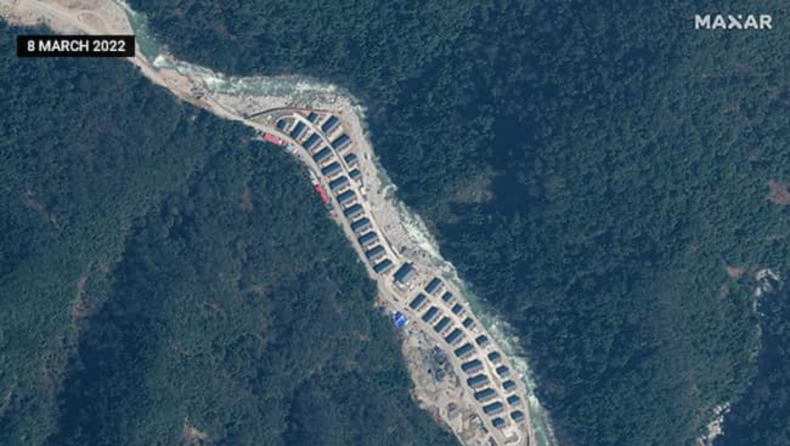- Satellite images show a Chinese village, constructed to the east of the Doklam plateau, now inhabited by cars parked outside every home.
o Newly captured image reveals China’s Inroads near Doklam in a possible bid to bypass Indian Defenses.
o A Chinese village, constructed east of the Doklam plateau where Indian and Chinese forces faced off is now fully inhabited.
Newly captured images expose China’s inroads near Doklam and armed forces wonder if it’s a bid to bypass Indian Defenses. For India, construction along the Amo Chu means that Chinese forces can end up gaining access to a strategic ridge in the adjacent Doklam plateau.

New satellite images accessed indicate that a Chinese village, constructed 9 km to the east of the Doklam plateau where Indian and Chinese forces had faced off in 2017, is now inhabited, with cars parked outside nearly every home.
Incidentally, the village, called Pangda by Beijing, lies within Bhutanese territory, trails of which were first reported in 2021.
Alongside Pangda is a finely marked all-weather carriageway, which is now part of China’s intensive land-grab in Bhutan. This enters 10 km into Bhutanese territory, on the banks of the rapid-flowing Amo Chu river.
For India, construction along the Amo Chu spells that Chinese forces may end up getting access to a strategic ridge in the Doklam plateau.
This would provide to them with a direct line of sight to India’s invaluable Siliguri corridor, the narrow piece of land that joins the northeast states with the rest of the country.
In 2017, Indian soldiers prevented Chinese workers from getting to this ridge in Doklam called Jhamperi. There is now growing concern that China is trying to bypass Indian defenses in the West by approaching the same ridge through this method.
‘Pangda village and the ones to its North and South are examples of the Chinese trying to establish their legitimacy over Jhamperi ridge and the Doklam plateau, Lt General Praveen Bakshi (retd) said. Bakshi was India’s Eastern Army Commander when the Doklam face-off took place in 2017.
Widespread Chinese efforts at constructing villages along frontiers that it disputes are a manner of giving legitimacy to its territorial claims.
Sources in the Army Headquarters stated that the Army maintains a continuous vigil on all activities along borders, especially those that trespass upon the territorial integrity and sovereignty of the nation.
For this, important mechanisms and safeguards to meet any contingencies are in place. The new satellite photos, sourced from Maxar, indicate that a second village along the Amo Chhu river valley is bound for completion while China has stepped up construction of a third village further down South.
The speedy development of this remote area is noteworthy, underlining how China is lengthening its borders unchallenged, said Damien Symon, a geospatial intelligence researcher at The Intel Lab who studied the latest images.
The road construction activity in this isolated sector highlights efforts taken by Chinese authorities to ensure all year, uninterrupted connectivity to remote, new habitats across its frontier, he adds.
Bhutan has next to no ability to prevent China’s annexation of its territory. Bhutan’s Ambassador, Major General Vetsop Namgyal, in New Delhi refused to comment on the state of China’s construction in the Amo Chu Valley, implying that Thimphu was involved in border talks.
China’s village and road construction activity in the Amo Chhu river valley lies approximately 30 km south of Beijing’s biggest land grab, which has been noticed in the last year.
Six settlements have been constructed in a previously uninhabited area in a 110-square km tract of land which Beijing contests. All of these settlements put pressure on Indian defenses in Sikkim.
The developments on the Bhutan front come when India is trying to persuade China to withdraw from the points it has occupied in Ladakh since 2020. There have been 16 rounds of talks so far with next to no headway reported in the last round held on Sunday.













